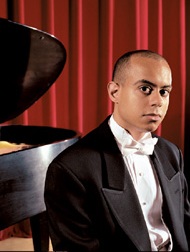Pianist Goodyear, Järvi and the CSO Kick Off Bartok Project Splendidly
Mary Ellyn Hutton
Posted: Jan 10, 2009
Posted: Jan 10, 2009
 Stewart Goodyear |
It was, of course, pure coincidence that Paavo Järvi and the Cincinnati Symphony Orchestra opened their first concert of 2009 with Haydn’s Symphony No. 82, subtitled the “Bear.” But what a commentary on the state of the economy. It was a wholly amiable, even cuddly bear, so one can hope the stock market will play out similarly in the future. The concert had historical resonance for the CSO, since it featured Bartok’s Piano Concerto No. 1, given its U.S. premiere by the CSO led by Fritz Reiner on tour at Carnegie Hall in 1928. Bartok himself was at the keyboard, as he was when the Concerto was repeated later at Emery Auditorium in Cincinnati.
Friday’s pianist was the remarkable Stewart Goodyear in the first performance of the work on CSO concerts since 1982, when pianist Malcolm Frager was guest artist with CSO associate conductor Bernard Rubenstein. The concert closed with Schumann’s Symphony No. 1 (“Spring”).
Bartok’s First Concerto is motivic, percussive and quite taxing for both pianist and orchestra. It was a true collaborative effort, and Canadian born Goodyear and the CSO were well matched to each other. Piano and timpani pounded out the opening bars, setting the stage for a horn motif right out of Stravinsky’s “Rite Spring.” There was lots of imitative counterpoint, with piccolo and woodwind fillips echoing the piano at one point and lots of scalar motion creating a rather savage effect. The Andante, an example of Bartok’s famous “night music,” is set for piano, percussion and winds. It began softly, with sparse textures, just piano and percussion, before the winds entered to a soft tramping by Goodyear on piano and a kind of march that billowed a bit before subsiding at the end. The concluding Allegro molto followed without a pause, taking off on drumbeats and trombone slides and setting up quite a ruckus. Goodyear sped over the keys and the CSO met him parry for joust in an exciting engagement of forces. Järvi, who led with zest, gave the members of CSO individual bows along with Goodyear, who earned a hearty ovation.
It was the beginning of a three-month Bartok Project by Järvi and the CSO, comprising four CSO concerts and one CSO Chamber Players concert and a multi-media presentation, “Bartok Revealed,” at the University of Cincinnati College-Conservatory of Music with keynote speakers Joel Hoffman and Douglas Knehans. Music to be heard will be Bartok’s “Dance Suite,” “Two Portraits,” “Music for Strings, Percussion and Celesta” (CSO) and Sonata for Two Pianos and Percussion (Chamber Players). Further information may be found at www.cincinnatisymhony.org
Haydn’s “Bear,” so-called because the final movement of the symphony reminded someone of the folk-like music heard in shows and street fairs featuring dancing bears, was a gem to open the concert. Järvi was at his musical and conductorial best, giving a subtle corporeal dimension to the music with scooping gestures of his arm and by hunching his shoulders and bouncing lightly on the podium. Textures and colors were just right and phrasing was exquisite. The second movement, an Allegretto theme and variations, began with a feather-like statement of the opening phrase answered by an assertive response. The graceful Minuet was followed by a delightful Vivace finale with what’s this? a drone and a merry melody as of Scottish highland vintage. The CSO winds sparkled, with silver-edged horns on top, wide dynamic contrasts and a drone reinforced by horns and timpani at the end. Definitely not your average bear (apologies to Hanna-Barberra).
Robert Schumann’s “Spring” Symphony was composed quickly in mid-winter, when he was in love and anxiously awaiting Spring. Järvi gave it an expansive opening fanfare (singable to the words of the poem that gave Schuman his inspiration for the symphony) followed by a wintry blast and a brisk Allegro molto vivace, as if to welcome the season’s arrival. The violins skittered nimbly, but to this listener some of the elan was missing. The Larghetto was lovely and quite romantic but, again, with a palpable tinge of seriousness. The Scherzo was quite brisk, almost impatient at times, a feeling that continued into the final Allegro animato e grazioso. The strings stumbled a bit at one point (a transitional moment) but Järvi had fun with the movement and overall, it had a winning impetuosity quite compatible with that of a young man in love.
Comments